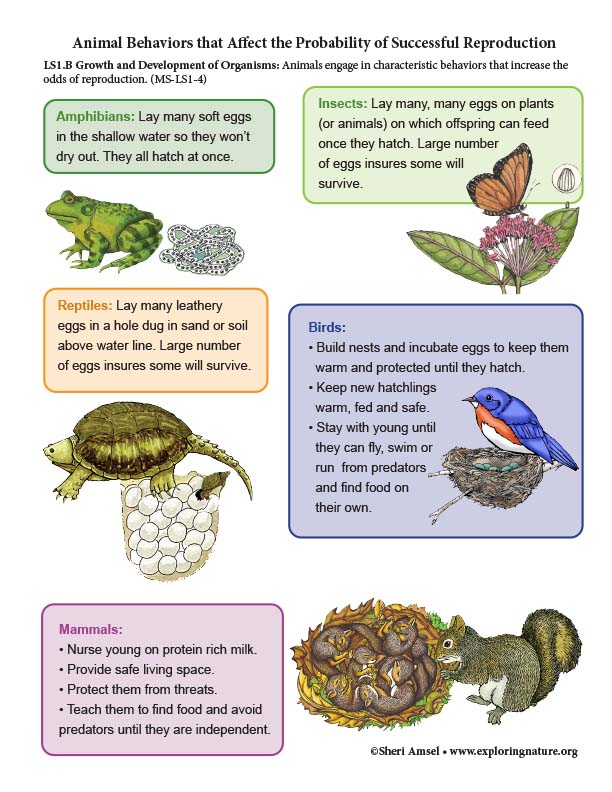

Animals engage in characteristic behaviors that increase the odds of reproduction.
In mammals, females give birth to a small number young that are generally small and helpless at birth, yet they survive. This is because mammals feed and protect their young until they can survive on their own. Females produce milk (lactate) that they feed to their young (nursing) until the young can find and eat food on their own. Mammals provide a safe living space where they watch over young until they can survive out in the world. This might be a nest, den or burrow, a mother’s protective pouch, or just a central place in the protective herd. Mammals also teach their young techniques for finding food and escaping predators, before they go out on their own.
Birds are born in hard-shelled eggs. Most bird parents build a nest in a tree, burrow, or tree hole and incubate the eggs with their own body heat to keep them warm and safe until they hatch. Hatchling birds are small and helpless. The parents bring them food and continue to keep them warm and dry. Birds will also teach their young how to get food and avoid danger. They will stay with them until they can fly, swim or run away on their own.
Amphibians include frogs, toads and salamanders. They lay a large number of soft eggs in the water. Most amphibians do not watch over their eggs or keep them safe after they hatch. Only a few hatchlings survive - but usually some do survive. The large number of eggs produced is their successful reproductive behaviour.
Reptiles include snakes, lizards and turtles. They lay a large number of leathery eggs on land buried in the sand, soil or brushpile. Most do not watch over their eggs or keep them safe after they hatch. Only a few hatchlings survive - but usually some do survive. The large number of eggs produced is their successful reproductive behaviour. Hatchlings dig out of their nest and make their own way to safety. Some reptile parents, such as the American alligator, do watch over the nest and hatchling for a while. This helps more offspring survive.
Insects lay many, many eggs on plants (or animals) on which their offspring can feed when they hatch. This gives them a chance to feed and grow. Insect parents usually do not watch over their eggs or keep them safe after they hatch. Only a few hatchlings survive - but usually some do survive. The large number of eggs produced is their successful reproductive behaviour.
Think about these different groups of animals and how each has their own characteristic behaviors that increase the odds of reproduction.
LS1.B Growth and Development of Organisms: Animals engage in characteristic behaviors that increase the odds of reproduction. (MS-LS1-4)
Performance Expectations: Students who demonstrate understanding can:
MS-LS1-4. Use argument based on empirical evidence and scientific reasoning to support an explanation for how characteristic animal behaviors and specialized plan
Try this activity: Increasing the Odds of Reproduction - Critical Thinking (NGSS 6-8 Grade)
When you research information you must cite the reference. Citing for websites is different from citing from books, magazines and periodicals. The style of citing shown here is from the MLA Style Citations (Modern Language Association).
When citing a WEBSITE the general format is as follows.
Author Last Name, First Name(s). "Title: Subtitle of Part of Web Page, if appropriate." Title: Subtitle: Section of Page if appropriate. Sponsoring/Publishing Agency, If Given. Additional significant descriptive information. Date of Electronic Publication or other Date, such as Last Updated. Day Month Year of access < URL >.
Amsel, Sheri. "Growth and Development of Organisms - Reproductive Behaviors (NGSS 6-8 Grade)" Exploring Nature Educational Resource ©2005-2024. December 13, 2024
< http://www.exploringnature.org/db/view/Growth-and-Development-of-Organisms-Reproductive-Behaviors-NGSS-6-8-Grade >
